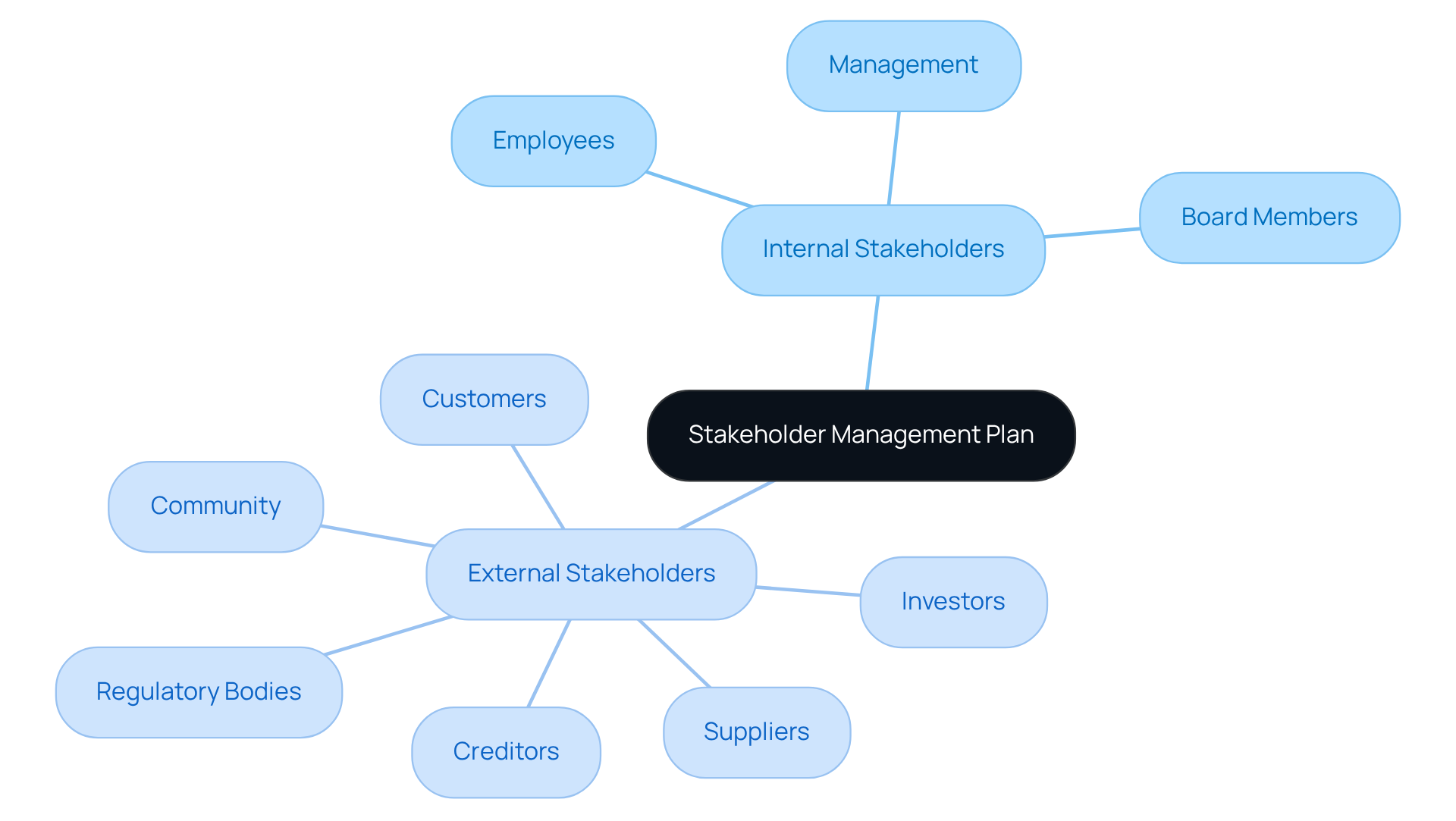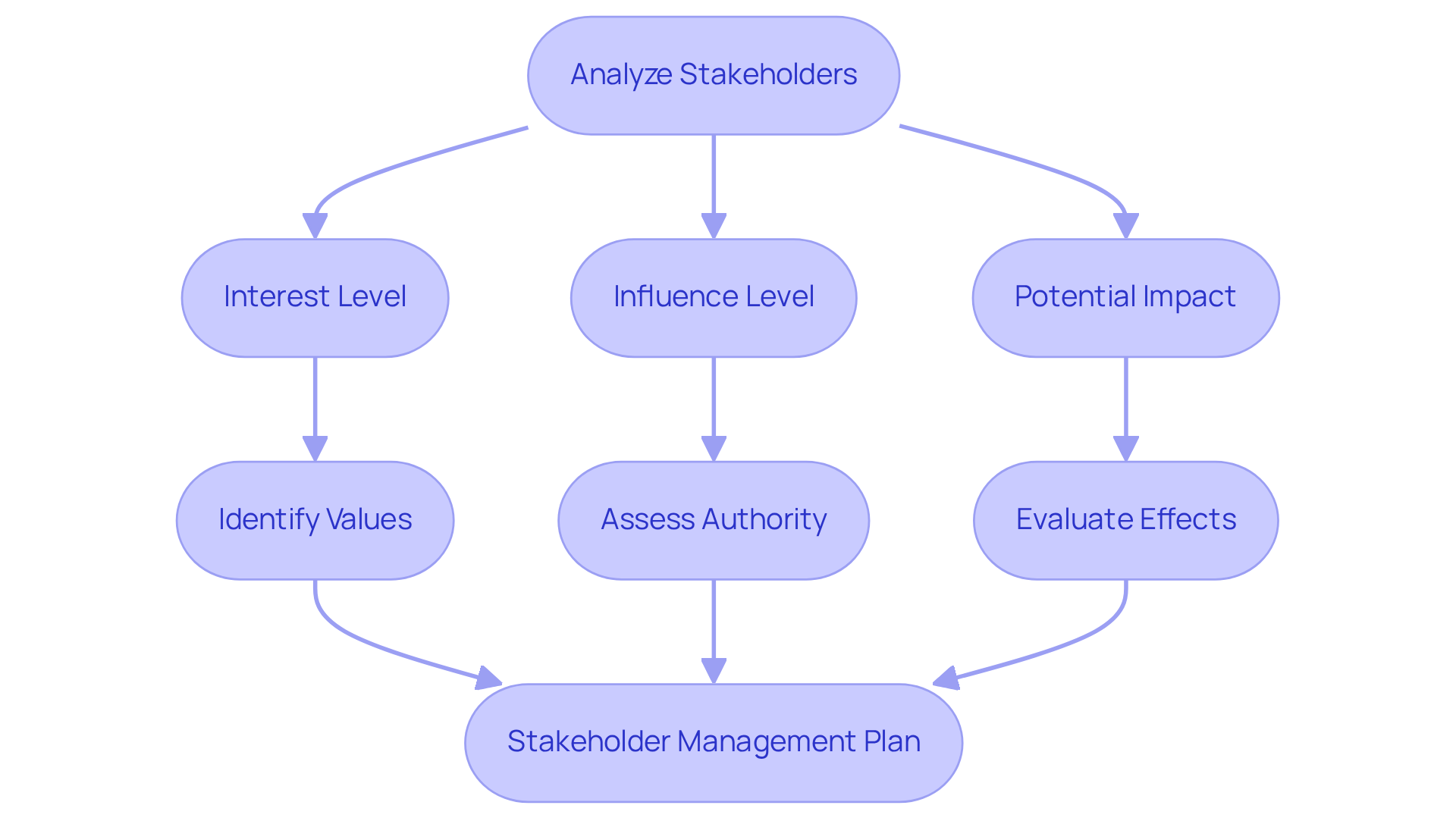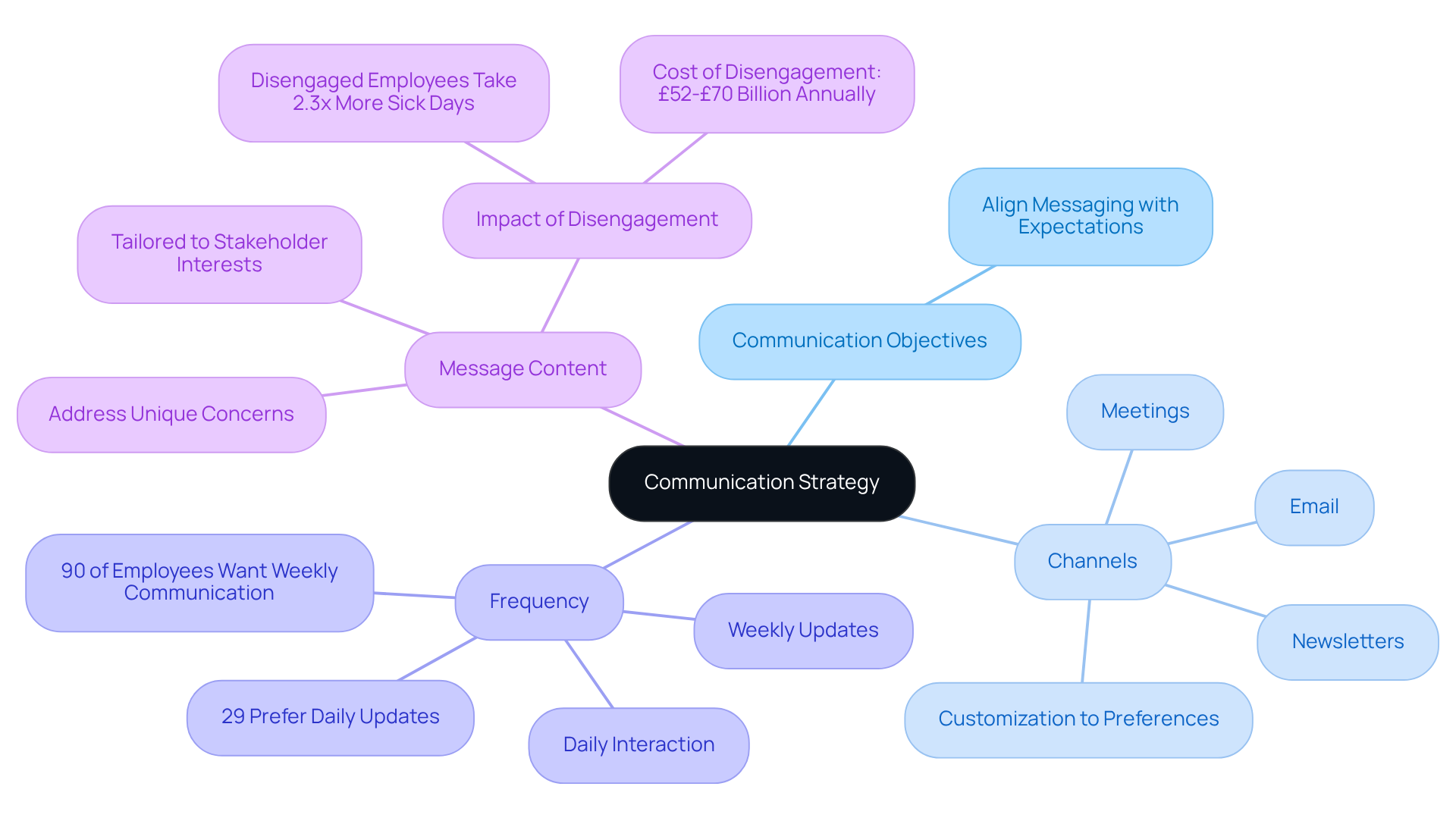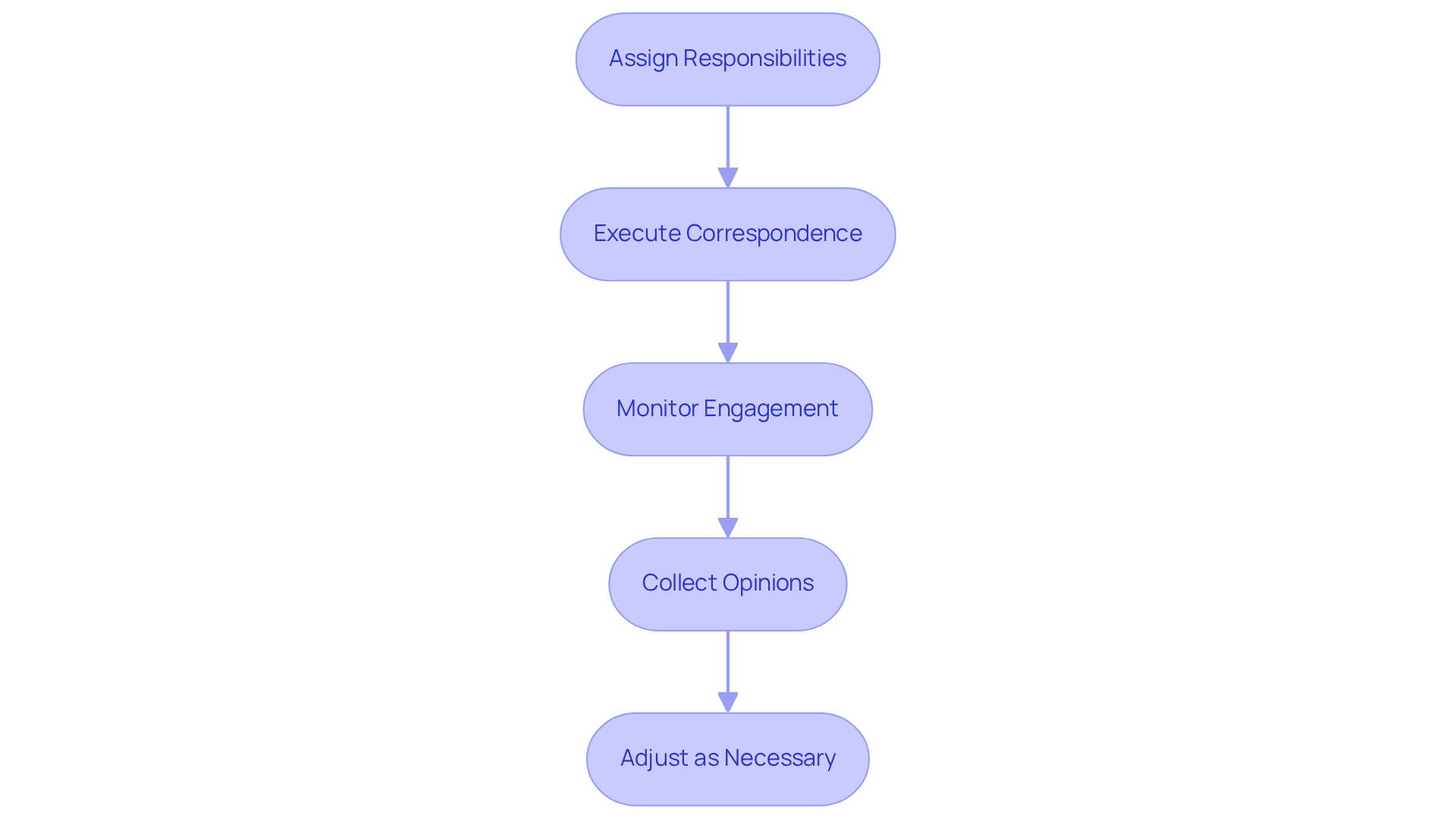Overview
The article outlines a five-step process for constructing an effective stakeholder management plan. It emphasizes the critical importance of:
- Identifying stakeholders
- Analyzing stakeholders
- Communicating with stakeholders
- Monitoring stakeholders
- Enhancing project success
Evidence shows that organizations with strong stakeholder engagement are significantly more likely to achieve their objectives. This effective management fosters trust, transparency, and collaboration among all parties involved, which is essential for driving project success.
Introduction
Effective stakeholder management can be the difference between a project's success and its failure. Yet, many organizations struggle to navigate this complex landscape. By constructing a well-defined stakeholder management plan, businesses can foster collaboration, build trust, and ensure that the voices of all involved parties are heard.
However, the challenge lies in:
- Identifying the right stakeholders
- Understanding their interests
- Maintaining effective communication throughout the project lifecycle
How can organizations develop a strategic approach that not only addresses these challenges but also enhances overall project outcomes?
Define Stakeholder Management and Its Importance
The stakeholder management plan construction is a critical process that involves systematic identification, analysis, planning, and execution of strategies designed to effectively engage interested parties. This process is essential, as interested parties can significantly influence the success or failure of a project or organization. By fostering trust, ensuring transparency, and promoting collaboration, the effective management of involved parties becomes particularly crucial during crises. Understanding the needs and expectations of these parties enables businesses to align their strategies accordingly, resulting in enhanced outcomes and sustainable growth.
In the context of turnaround and restructuring, the significance of managing involved parties escalates. Organizations must skillfully navigate complex relationships with creditors, employees, customers, and regulatory bodies. Transform Your Small/Medium Business provides comprehensive turnaround and restructuring consulting services, including interim management and . not only mitigates risks but also enhances the likelihood of achieving successful results in challenging situations. By prioritizing engagement with interested parties, businesses can secure the essential support and resources necessary to propel their recovery and growth initiatives.
Identify Your Stakeholders
Begin by compiling a comprehensive list as part of your stakeholder management plan construction, which includes all individuals, groups, or organizations with a vested interest in your project or business. This encompasses:
- Internal Stakeholders: Employees, management, and board members who play a direct role in operations.
- External Stakeholders: Customers, suppliers, investors, creditors, regulatory bodies, and the broader community.
Utilize to visualize connections and evaluate the influence and interest of each participant in the stakeholder management plan construction. This tactical method not only emphasizes involvement initiatives but also cultivates a cooperative atmosphere, guaranteeing that the appropriate participants are included at the appropriate moment. Research suggests that organizations employing mapping techniques can enhance their engagement effectiveness by as much as 30%, resulting in better project outcomes. By understanding the dynamics of relationship management, businesses can navigate challenges more effectively and drive sustainable growth.

Analyze Stakeholders and Their Interests
After recognizing your involved parties, the next essential step in the stakeholder management plan construction is to examine their interests and influence. This process involves several key considerations:
- Interest Level: Comprehend what each participant values most concerning your initiative or business. This understanding is crucial for the stakeholder management plan construction to align objectives with participant expectations.
- Influence Level: Assess the extent of authority each participant possesses to affect the outcome of the initiative. Identifying key contributors can greatly enhance the construction of your stakeholder management plan.
- Potential Impact: Evaluate how the project will influence each party, both positively and negatively. This understanding can direct your interactions and involvement efforts.
To effectively classify parties based on their interest and influence, for them. This tool not only assists in prioritizing engagement efforts but also customizes messaging strategies, which is crucial for stakeholder management plan construction to address the distinct requirements of each party involved. Research shows that companies that actively interact with interested parties are 50% more likely to achieve their major goals, which underscores the importance of stakeholder management plan construction. Moreover, a McKinsey study discovered that emphasizing communication with interested parties can result in an impressive 79% success rate in initiatives, three times greater than the norm. Furthermore, it's significant that 78% of initiatives thrive when participants are involved. By utilizing a participant analysis matrix, you can improve your initiative's chances of success and enhance the stakeholder management plan construction to cultivate stronger connections with key contributors. Additionally, incorporating real-time analytics via a client dashboard into your management process permits ongoing observation of engagement and performance, facilitating swift decision-making and modifications as required. This approach not only reinforces your strategic planning but also operationalizes lessons learned throughout the project lifecycle.

Develop a Communication Strategy
Developing a robust stakeholder management plan construction is essential for effectively interacting with every group involved. Consider the following components:
- Communication Objectives: Clearly outline the aims of your messaging efforts to align with participant expectations.
- Channels: Choose suitable communication methods—such as email, meetings, or newsletters—customized to the preferences of those involved. Research indicates that companies excelling in engaging parties are 40% more likely to complete projects on schedule and within budget. Furthermore, 85% of participants believe that engagement significantly impacts their perception of organizational transparency.
- Frequency: Establish a contact timetable that specifies how often you will engage with each group of stakeholders. Notably, over 90% of employees express a desire for weekly updates, with 29% preferring daily interaction. Initiatives with effective participant strategies succeed 83% of the time, underscoring the importance of regular engagement.
- Message Content: Tailor your messages to address the unique interests and concerns of each stakeholder. Effective interaction is vital, as disengaged employees are 2.3 times more likely to take sick days than their engaged counterparts. Additionally, disengagement costs the UK £52-£70 billion annually in lost productivity, highlighting the financial repercussions of ineffective interaction.
By implementing a clear and tailored communication strategy, you can cultivate informed, engaged, and supportive relationships with stakeholders, which is vital in the stakeholder management plan construction, ultimately enhancing project success and organizational performance. While focusing on is crucial, it should not detract from achieving your core objectives.

Implement and Monitor Your Stakeholder Management Plan
Once your party management plan is developed, effective implementation is crucial. Follow these steps to ensure success:
- Assign Responsibilities: Clearly designate team members to manage relationships with specific parties, ensuring accountability and focused involvement.
- Execute Correspondence: Begin interaction with interested parties as detailed in your outreach plan, using customized methods to satisfy their preferences.
- Monitor Engagement: Regularly evaluate the effectiveness of your communication and engagement efforts. Statistics show that organizations with are 30% more likely to succeed with new initiatives. Collect opinions to assess participant views and issues, as 58% of organizations acknowledge the importance of management in improving performance.
- Adjust as Necessary: Be flexible and ready to adapt your plan based on input from interested parties and evolving circumstances. Ongoing enhancement is crucial; initiatives with robust participant involvement succeed 83% of the time compared to just 32% for those neglecting attention to these connections.
By diligently implementing and monitoring your stakeholder management plan construction, you can ensure its relevance and effectiveness, ultimately driving the success of your project or organization.

Conclusion
Effective stakeholder management transcends mere procedural necessity; it stands as a strategic imperative that can significantly shape the trajectory of any project or organization. By comprehensively understanding and engaging with all parties involved, businesses can cultivate collaboration and trust, ultimately leading to enhanced outcomes and sustainable growth. A meticulously constructed stakeholder management plan acts as a roadmap, guiding organizations through complex relationships and aligning their objectives with stakeholder expectations.
Throughout this article, we have outlined essential steps for constructing an effective stakeholder management plan. These steps encompass:
- Identifying stakeholders
- Analyzing their interests and influence
- Developing a tailored communication strategy
- Implementing and monitoring the plan
Each of these components is critical in ensuring that stakeholders feel valued and engaged, which is paramount for project success. The evidence presented underscores the substantial impact that effective stakeholder management can have on achieving organizational goals, with statistics indicating that companies prioritizing stakeholder engagement experience markedly greater success.
In conclusion, the significance of a structured stakeholder management plan cannot be overstated. Organizations are urged to embrace these best practices, as they not only mitigate risks but also enhance the likelihood of successful outcomes. By investing in stakeholder relationships, businesses can secure the necessary support and resources to thrive, especially in challenging times. Prioritizing effective stakeholder management is not merely a tactical choice; it represents a strategic advantage that can propel organizations toward greater resilience and success.
Frequently Asked Questions
What is stakeholder management?
Stakeholder management is the process of systematically identifying, analyzing, planning, and executing strategies to effectively engage individuals or groups that have a vested interest in a project or organization.
Why is stakeholder management important?
It is important because stakeholders can significantly influence the success or failure of a project or organization. Effective management fosters trust, ensures transparency, and promotes collaboration, which is particularly crucial during crises.
How does stakeholder management contribute to organizational growth?
By understanding the needs and expectations of stakeholders, businesses can align their strategies accordingly, leading to enhanced outcomes and sustainable growth.
What are the different types of stakeholders?
Stakeholders can be categorized into internal stakeholders, such as employees, management, and board members, and external stakeholders, including customers, suppliers, investors, creditors, regulatory bodies, and the broader community.
How can organizations identify their stakeholders?
Organizations can identify their stakeholders by compiling a comprehensive list of all individuals, groups, or organizations with a vested interest in their project or business.
What tools can be used to manage stakeholders effectively?
Mapping tools can be utilized to visualize connections and evaluate the influence and interest of each stakeholder, enhancing engagement effectiveness and project outcomes.
What is the significance of stakeholder management in turnaround and restructuring situations?
During turnaround and restructuring, managing stakeholders becomes crucial as organizations must navigate complex relationships with creditors, employees, customers, and regulatory bodies to mitigate risks and achieve successful results.
How can effective stakeholder management impact project outcomes?
Research suggests that organizations employing mapping techniques can enhance their engagement effectiveness by up to 30%, resulting in better project outcomes and driving sustainable growth.




